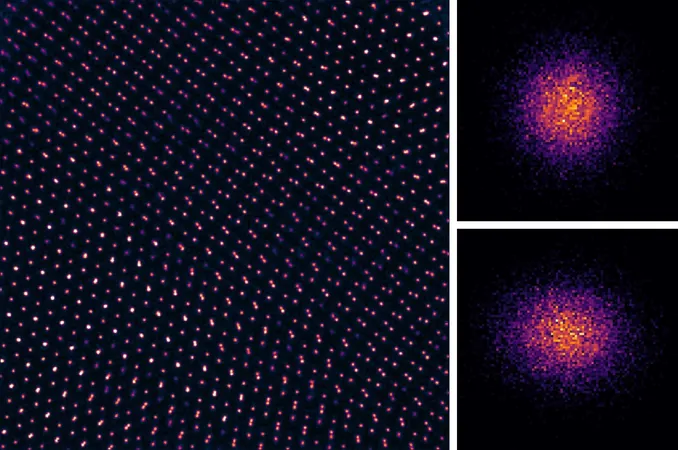
Revolutionary Discovery: Groundbreaking Images of Atoms Unveil New Vibrational Dynamics
2025-08-25
Author: Ming
Unveiling the Hidden Vibrations of Atoms
In a stunning breakthrough, researchers in the United States have directly captured images of previously theoretical atomic vibrations known as moiré phasons. This marks a pivotal moment in our understanding of how atoms behave in twisted two-dimensional materials, with implications for heat and charge transport and the interactions of quantum phases.
Yichao Zhang from the University of Maryland, who co-led the research with Pinshane Huang from the University of Illinois at Urbana-Champaign, stated, "Phasons had only been predicted until now; seeing them is a game changer for understanding lattice vibrations in two-dimensional quantum materials."
The Mystique of Moiré Patterns
When two sheets of two-dimensional materials are twisted and stacked, they create a moiré pattern—an intricate superlattice consisting of zones of rotational alignment (labeled AA or AB) and areas of disruption known as solitons. These unique structures give rise to distinct vibrational modes called moiré phonons, which can vary based on the angle of twist between the layers, significantly affecting the materials' physical characteristics.
From Theory to Reality: Observing Phasons
Until this groundbreaking research, phasons remained phantom phenomena, only existing in theoretical discussions. The study, published in the prestigious journal Science, utilized an advanced microscopy technique called electron ptychography, achieving an astonishing spatial resolution as fine as 15 picometers. This allows for the detection of subtle, thermally-driven atomic vibrations.
Zhang elaborated, "We mapped how atoms vibrate throughout the moiré superlattice, discovering fascinating patterns. The vibrations differed in size based on the stacking type, aligning perfectly with theoretical predictions for moiré phasons."
Pushing Scientific Boundaries
Having previously been limited to nanometer-scale observations, Zhang recognized that electron ptychography could enhance precision to the picometer scale, crucial for detecting moiré phasons. Studying twisted 2D materials is vital, as they can demonstrate remarkable electronic phenomena—including superconductivity and correlated insulating states. Yet, the interplay of these vibrational dynamics remained poorly understood, largely because phasons are low-energy and spatially variable.
To address these challenges, the team meticulously refined their use of electron ptychography, validating their findings with robust models and simulations.
Future Possibilities: Controlling Atomic Vibrations
This research opens the door to a new frontier in manipulating how vibrations act in complex two-dimensional systems. Zhang explains, "Phasons influence heat flow, electron mobility, and even the emergence of new matter phases. Mastering these vibrations could enable us to design materials with customizable thermal and electronic properties, essential for next-generation low-power electronics, quantum computing, and nanoscale sensors."
Exploring the Far-Reaching Implications
Electron ptychography is not just a tool for this study; it represents a significant advancement in investigating lattice dynamics across various advanced materials. The research team plans to employ this technique further to understand how imperfections like defects and strains impact phason behavior, as these factors can substantially impede material performance.
Zhang concludes, "Our ultimate goal is to discern how phasons react to external changes—such as temperature variations or applied fields—potentially offering profound insights into their interactions with electrons, excitons, and other quantum excitations. The implications of our findings could reshape the future of material science as we know it."



 Brasil (PT)
Brasil (PT)
 Canada (EN)
Canada (EN)
 Chile (ES)
Chile (ES)
 Česko (CS)
Česko (CS)
 대한민국 (KO)
대한민국 (KO)
 España (ES)
España (ES)
 France (FR)
France (FR)
 Hong Kong (EN)
Hong Kong (EN)
 Italia (IT)
Italia (IT)
 日本 (JA)
日本 (JA)
 Magyarország (HU)
Magyarország (HU)
 Norge (NO)
Norge (NO)
 Polska (PL)
Polska (PL)
 Schweiz (DE)
Schweiz (DE)
 Singapore (EN)
Singapore (EN)
 Sverige (SV)
Sverige (SV)
 Suomi (FI)
Suomi (FI)
 Türkiye (TR)
Türkiye (TR)
 الإمارات العربية المتحدة (AR)
الإمارات العربية المتحدة (AR)